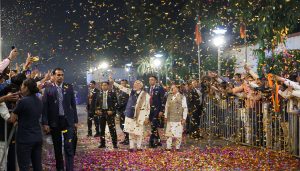Prime Minister Narendra Modi’s Bharatiya Janata Party (BJP) has bounced back less than six months after its narrow victory in parliamentary elections.
Of the three states and one Union Territory that voted in assembly elections over the last couple of months, the BJP has won two states and wrested several seats from opposition parties in different by-elections. This is expected to embolden the party to press ahead on contentious items on its agenda.
Following its sharply reduced tally in the parliamentary elections in Haryana, the BJP was expected to lose in the October assembly elections in the state. Yet it returned to power for a third consecutive term.
In Maharashtra, India’s second-largest state and home to Mumbai, India’s financial capital, the opposition Congress-led INDIA bloc won 29 of Maharashtra’s 48 parliamentary seats in the May-June parliamentary election. However, the recent assembly elections saw a total reversal. The BJP-led alliance won 230 of 288 seats in the Maharashtra assembly, winning a four-fifth majority.
While the INDIA bloc won Jharkhand, this is a relatively minor state — home to a third of the size of Maharashtra’s population. In October, the BJP also faced a setback in the assembly election of the northern Union Territory of Jammu and Kashmir, where the INDIA bloc notched up a comprehensive victory.
Political scientist Ajay Gudavarthy, who teaches at New Delhi’s Jawaharlal Nehru University, told The Diplomat that following its electoral debacle in the general election, the BJP worked hard as it was worried that the opposition was setting a counter-narrative. With the Haryana and Maharashtra election victories, it has successfully taken the steam out of the opposition narrative, he said.
Gudavarthy pointed out that both in Haryana and Maharashtra, the BJP formed a social configuration of castes against the dominant Jat and influential Maratha communities, respectively. “The BJP, despite being a conservative party, played out the optics of a progressive transformation for forging these social configurations,” Gudavarthy said.
The BJP showed strategic flexibility not only in forging social configurations but also in modifying its economic strategy. The party has in the past criticized welfare/subsidy schemes promised by opposition parties and dubbed them as revdi or harmful politics of freebies and dole.
However, it has been flirting with the revdi tactic since the Madhya Pradesh assembly election in November last year, and after the 2024 parliamentary election upset, embraced it more robustly, promising “freebies” to voters, especially women and the poor, in the Haryana, Maharashtra and Jharkhand election campaigns.
The BJP also shed its over-reliance on Modi’s appeal and focused heavily on the local leadership in both Maharashtra and Haryana. Only in Jharkhand did the BJP bank on leaders from outside the state.
While making these adjustments, the party persisted with communally polarizing rhetoric. It stuck to its high-pitched Hindu nationalist campaign despite being criticized for being divisive, hateful and communal.
While they came due to the success of its successful election strategy, the victories, especially in Maharashtra, are likely to encourage the BJP to push through on its ideological agenda, including amending legislation on the Waqf Board that manages the Muslim religious properties, implementing the Uniform Civil Code, and holding elections at all levels simultaneously.
Modi’s third consecutive term as prime minister was expected to be difficult due to the BJP’s reduced strength in parliament — its tally was 32 short of the majority mark — and its consequent dependence on the support of its allies.
In July, in the first by-elections held after the parliamentary elections, the INDIA bloc won 10 out of 13 seats, which prompted jubilant opposition leaders to claim that it reflected the changing political climate of the country. The BJP’s popularity appeared to be declining.
However, in the November by-election for 48 assembly seats, the BJP recovered ground in the north, winning most seats in Uttar Pradesh, Uttarakhand, Bihar, and Gujarat.
The by-election results are particularly significant for Uttar Pradesh, where the BJP suffered a setback in the parliamentary election. The assembly by-elections saw the BJP hold on to its own seats and wrest control over two seats from the opposition bloc.
However, the party failed to make any impression in by-elections in opposition-ruled West Bengal, Kerala and Karnataka.
“The Haryana, Maharashtra and by-election results will increase the BJP’s power to drive hard bargains with their allies. With the BJP retaining significant popularity, its allies will tend to stick together,” an opposition Trinamool Congress parliamentarian told The Diplomat, requesting anonymity.
Meanwhile, in August, the BJP and its allies touched the majority mark in the Rajya Sabha, the upper House of the Indian parliament. For a Bill to become an Act, it must be passed in both Houses of Parliament. Enacting legislation has gotten easier for the Modi government
Parliament’s winter session has begun. Buoyed by its recent electoral victories, the BJP can be expected to go on an offensive mode.

































